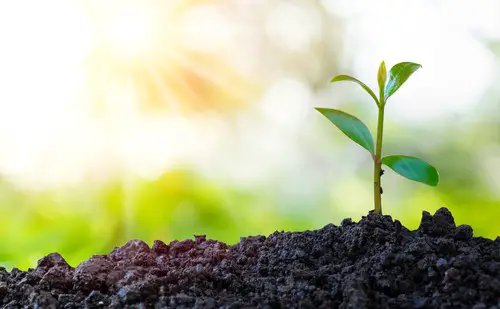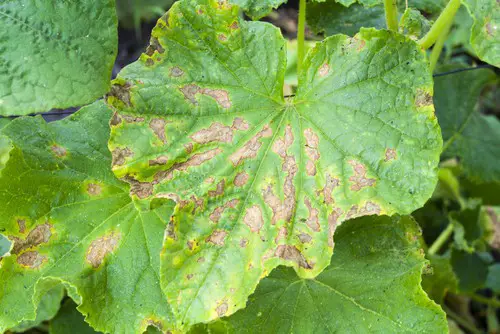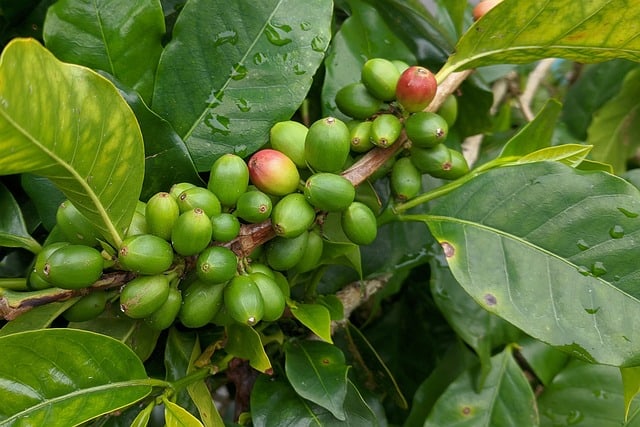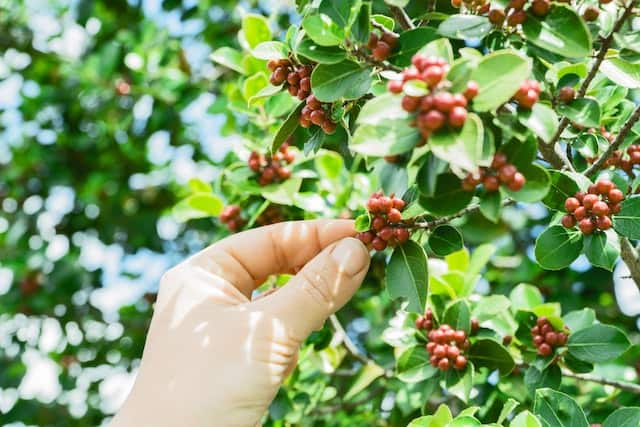Coffee plants are a popular indoor plant that can add a touch of greenery to any space. However, even with proper care, coffee plants can still die. Understanding the causes of a dying coffee plant is crucial in preventing and treating the issue.
Several factors can contribute to coffee plant dying, including improper watering, lack of sunlight, and poor soil quality. Overwatering can lead to root rot, while underwatering can cause the plant to become dehydrated.
Additionally, coffee plants require specific levels of sunlight and humidity to thrive, and improper levels of either can cause the plant to decline.
Key Takeaways on Coffee Plant Dying
- Proper watering, sunlight, and soil quality are crucial to the survival of a coffee plant.
- Recognizing the signs of a dying coffee plant is important in treating the issue.
- Treating pests, diseases, and nutrient deficiencies can also help prevent a coffee plant from dying.
See these other top posts in this category:
Understanding Coffee Plants

Coffee plants belong to the Rubiaceae family and are also known as coffee trees. They are native to tropical regions of Africa and thrive in warm, humid climates. Coffee plants can grow up to 30 feet tall in the wild, but when grown indoors, they usually reach a height of 6-8 feet.
Coffee plants are grown for their beans, which are roasted and ground to make coffee. The beans are located inside the fruit of the coffee plant, which is called a cherry. The cherries are harvested when they are ripe and then processed to remove the pulp and skin, leaving behind the coffee beans.
To grow coffee plants, it is important to provide them with the right conditions. They need well-draining soil that is rich in organic matter and a pH level between 6.0 and 6.5. Coffee plants also need plenty of sunlight, but not direct sunlight, as this can scorch the leaves. They prefer temperatures between 60-70°F, and humidity levels of around 50-60%.
One of the most common problems with coffee plants is overwatering. They prefer to be kept on the drier side, as too much water can lead to root rot. It is important to allow the soil to dry out slightly between waterings. Coffee plants also benefit from regular fertilization, as they are heavy feeders.
Identifying Signs of a Dying Coffee Plant
When a coffee plant is dying, it will exhibit several signs that indicate it is in distress. Identifying these signs early on can help you take action and save your plant. Here are some common signs that your coffee plant is dying:
- Yellowing leaves: Yellowing leaves are a sign that your coffee plant is not getting enough nutrients. This could be due to overwatering, underwatering, or nutrient deficiencies. If you notice yellowing leaves, check the soil moisture and nutrient levels.
- Brown leaves: Brown leaves can indicate a few different problems. If the brown spots are dry and crispy, it may be due to underwatering. If the brown spots are wet and mushy, it could be due to overwatering or a fungal disease.
- Wilting: Wilting is a sign that your coffee plant is not getting enough water. This could be due to underwatering or soil that does not retain moisture well. If you notice wilting, check the soil moisture levels and adjust your watering schedule as necessary.
- Stunted growth: Stunted growth is a sign that your coffee plant is not getting enough nutrients or light. This could be due to poor soil quality, nutrient deficiencies, or lack of sunlight. If you notice stunted growth, check the soil quality, nutrient levels, and lighting conditions.
It is important to note that these signs can also be caused by pests or diseases, so it is important to thoroughly inspect your plant for any signs of infestation or infection. By identifying these signs early on, you can take action and save your coffee plant before it is too late.
Role of Sunlight

Sunlight is an essential factor for the growth and survival of coffee plants. Coffee plants require bright but indirect sunlight to thrive. Direct sunlight can burn the leaves and cause damage to the plant. Similarly, lack of sunlight can make the plant weak and prone to disease. Therefore, it is important to provide the right amount of sunlight to the coffee plant.
Coffee plants typically need 4-6 hours of bright but indirect sunlight per day. They should be placed near a window that receives bright but indirect sunlight. If the plant is not getting enough sunlight, it can become weak and prone to disease. On the other hand, if the plant is getting too much direct sunlight, it can burn the leaves and cause damage to the plant.
It is important to note that the amount of sunlight required by the coffee plant may vary depending on the climate and the time of the year. In the summer months, the plant may require more shade to protect it from the hot sun. In the winter months, the plant may require more sunlight to help it grow.
If the coffee plant is not getting enough sunlight, it can become weak and prone to disease. The leaves may turn yellow and fall off, and the plant may stop growing. If this happens, the plant should be moved to a location where it can receive more sunlight.
Importance of Proper Watering
Proper watering is crucial to the health of a coffee plant. Overwatering or underwatering can both cause significant damage to the plant, leading to wilting, yellowing, and browning. Therefore, it is essential to find the right balance when it comes to watering a coffee plant.
When watering a coffee plant, it is important to ensure that the soil is moist but not waterlogged. Watering should be done evenly, without too much or too little water. If a plant is overwatered, it can lead to root rot, which can be fatal. On the other hand, if a plant is underwatered, it can cause wilting, yellowing, and browning.
One way to ensure proper watering is to check the drainage of the soil. If the soil does not drain well, it can lead to waterlogging, which can cause root rot. Therefore, it is important to make sure that the plant is in a pot with good drainage holes and that excess water can drain out easily.
Another way to ensure proper watering is to water the plant thoroughly but infrequently. This means that the plant should be watered deeply, allowing the water to penetrate the soil, but then allowed to dry out before watering again. This will help prevent overwatering and ensure that the plant is getting the right amount of water.
Soil Quality and Drainage

Coffee plants require well-draining soil that is rich in organic matter. If the soil is too compact or lacks nutrients, the plant can suffer. Inadequate drainage can lead to root rot, which can ultimately kill the plant.
To ensure proper soil quality, it is recommended to use a rich, peat-based potting soil with excellent drainage. Coffee plants prefer acidic soil, so if the plant is not thriving, adding organic matter such as sphagnum peat moss can help lower the soil pH. The ideal pH range for coffee plants is closer to 6 to 6.5.
If the soil is too acidic, it can be neutralized by adding calcitic lime. If it also lacks magnesium, dolomitic lime can be used instead. Low acidity can also be an issue, which can be balanced out through frequent fertilization.
It is important to note that poor drainage can also be a factor in the health of a coffee plant. If the soil is not well-draining, the plant can suffer from root rot, which can ultimately kill the plant. To ensure proper drainage, it is recommended to use a pot with drainage holes and avoid over watering the plant.
Temperature and Humidity Factors
Temperature and humidity are two important factors that can affect the health of coffee plants. Coffee plants thrive in warm and humid environments, but extreme temperatures and low humidity levels can cause stress and even death.
Coffee plants prefer temperatures between 60 and 70 degrees Fahrenheit (15 to 21 degrees Celsius). If the temperature drops below 50 degrees Fahrenheit (10 degrees Celsius), the plant can go into shock and die.
On the other hand, if the temperature rises above 80 degrees Fahrenheit (27 degrees Celsius), the plant can suffer from heat stress, which can cause the leaves to wilt and turn brown. Therefore, it is important to keep the temperature within the optimal range to ensure the health of the coffee plant.
Humidity is also crucial for coffee plants. Low humidity levels can cause the leaves to dry out and drop, while high humidity levels can promote the growth of mold and fungus. Coffee plants prefer humidity levels between 60 and 70 percent. If the humidity drops below 40 percent, it is recommended to use a humidifier to increase the moisture in the air.
Maintaining the optimal temperature and humidity levels can be challenging, especially in dry climates or during extreme weather conditions. However, there are several ways to regulate these factors. For example, placing a tray of water near the plant can increase humidity levels, while using a fan or shade cloth can help regulate the temperature.
Recognizing and Treating Diseases
Coffee plants are susceptible to various diseases that can affect their growth, yield, and quality of coffee beans. Recognizing and treating these diseases early on is crucial to ensure a healthy and productive crop.
1. Common Coffee Plant Diseases

The most common coffee plant diseases are root rot, coffee rust, and fungal infections. Root rot is caused by overwatering and poor drainage, leading to the roots’ decay.
Coffee rust is a fungal disease that affects the leaves, causing them to fall off prematurely, and ultimately leading to stunted growth and reduced yields. Fungal infections can also cause leaf loss and reduced yields.
2. Identifying the Symptoms
To identify the symptoms of coffee plant diseases, growers should regularly inspect their plants. Symptoms of root rot include yellowing leaves, wilting, and a foul odor from the soil. Symptoms of coffee rust include yellow-orange spots on the leaves, which turn brown and fall off. Fungal infections can cause brown spots on the leaves and stem.
3. Treating the Diseases
Treating coffee plant diseases involves a combination of prevention and intervention. To prevent root rot, growers should ensure proper drainage and avoid overwatering. For coffee rust, growers should remove and destroy infected leaves and apply fungicides. Fungal infections can also be treated with fungicides.
Pests and How to Treat Them
Coffee plants are susceptible to pests that can cause damage to the plant and ultimately lead to its death. The most common pests that affect coffee plants are spider mites and mealybugs.
1. Spider Mites
Spider mites are tiny pests that can cause significant damage to coffee plants. They feed on the plant’s sap, causing the leaves to turn yellow and fall off. If left untreated, spider mites can quickly spread and kill the plant.
To treat spider mites, it is essential to act quickly. The first step is to remove any infected leaves and dispose of them. Next, spray the plant with a mixture of water and insecticidal soap. Repeat this process every few days until the spider mites are gone.
2. Mealybugs
Mealybugs are another common pest that affects coffee plants. They feed on the plant’s sap, causing the leaves to become discolored and distorted. Mealybugs are easily recognizable by their white, cotton-like appearance.
To treat mealybugs, it is essential to remove them manually. Use a cotton swab dipped in rubbing alcohol to wipe the bugs off the plant. Repeat this process every few days until the mealybugs are gone.
Prevention is the best way to avoid pest infestations on coffee plants. Regularly inspect the plant for signs of pests and remove any infected leaves immediately. Keep the plant well-watered and fertilized to promote healthy growth and make it less susceptible to pests.
Nutrient Needs and Fertilization

Coffee plants require specific nutrients to grow and produce healthy fruit. Nitrogen, phosphorus, and potassium are the most important macronutrients required by coffee plants. Additionally, coffee plants also need micronutrients such as iron, zinc, and magnesium to grow.
A balanced fertilizer is essential for healthy coffee plant growth. Fertilizers with a ratio of 3:1:2 or 4:1:2 (nitrogen, phosphorus, and potassium) are ideal for coffee plants. Applying too much nitrogen can lead to excessive vegetative growth, which can reduce fruit production.
It is crucial to use high-quality fertilizers to ensure that the coffee plant receives all the necessary nutrients. Organic fertilizers such as compost, manure, and bone meal can provide essential micronutrients to the soil.
When fertilizing coffee plants, it is essential to consider the soil type and pH. Coffee plants grow best in well-draining soil with a pH between 5.0 and 6.0. Soil testing can help determine the specific nutrient needs of the soil.
Fertilizers should be applied in small amounts regularly throughout the growing season. Over-fertilizing can lead to nutrient burn, which can damage the plant. Nitrogen-rich fertilizers should be applied during the vegetative growth stage, while phosphorus-rich fertilizers should be applied during the flowering stage.
Pruning and Care
When it comes to caring for a coffee plant, pruning is an essential task that should not be overlooked. Pruning helps to keep the plant healthy, encourages new growth, and prevents it from becoming too large.
To prune a coffee plant, it is recommended to use clean, sharp pruning shears. Cut the stem at a 45-degree angle, ¼-inch (6.4 mm) above where the leaf attaches to the stem (axil), paying attention to top growth to retard size. It is also important to remove any suckers at this time as well as any dead or dying limbs while leaving the largest branches.
In addition to pruning, proper care is crucial to the health of a coffee plant. Here are some tips to keep in mind:
- Light: Coffee plants prefer bright, indirect light. Too much direct sunlight can scorch the leaves, while too little light can cause the plant to become leggy and weak.
- Water: Overwatering can lead to root rot, while underwatering can cause the plant to wilt and die. Water your plant only when the top inch of soil feels dry to the touch.
- Humidity: Coffee plants thrive in a humid environment. Make sure to give them a daily misting, or add a humidifier nearby.
- Temperature: Coffee plants prefer temperatures between 65-80°F.
- Fertilizer: Fertilize your coffee plant once a month during spring and summer with a liquid fertilizer diluted to half strength.
By following these simple tips and regularly pruning your coffee plant, you can help ensure that it stays healthy and vibrant for years to come.
Environmental Factors
Coffee plants are sensitive to environmental factors and can easily die if exposed to unfavorable conditions. The following are some environmental factors that can cause coffee plants to die:
1. Air
Air quality is an important factor that can affect the growth and survival of coffee plants. Poor air quality can lead to the accumulation of harmful gases and pollutants that can damage the leaves and roots of the plant. Coffee plants require fresh air to thrive, and stagnant air can lead to the growth of harmful fungi and bacteria.
2. Wind
Wind can also affect the growth and survival of coffee plants. Strong winds can damage the leaves and branches of the plant, making it vulnerable to pests and diseases. Coffee plants require a moderate amount of wind to strengthen their stems and branches, but excessive wind can be detrimental to their growth.
3. Drafts
Drafts are sudden changes in temperature and humidity that can occur in enclosed spaces. They can cause stress to coffee plants, leading to their death. Coffee plants require a stable environment with consistent temperature and humidity levels to thrive.
4. Environmental Factors
Environmental factors such as climate change, deforestation, and soil erosion can have a significant impact on the growth and survival of coffee plants.
Climate change can alter the temperature and rainfall patterns, making it difficult for coffee plants to grow in their natural habitat. Deforestation can lead to soil erosion, which can affect the nutrient levels of the soil and the growth of coffee plants.
Additional Tips for Healthy Coffee Plants

To ensure healthy coffee plants, there are a few additional tips that can be followed.
1. Home Environment
The home environment can have a significant impact on the health of coffee plants. It is essential to place the plant in a room with bright, indirect sunlight. Direct sunlight can cause the leaves to burn, while low light can cause the plant to become weak and leggy.
Additionally, coffee plants prefer temperatures between 60 and 75 degrees Fahrenheit, so it is important to keep them away from cold drafts or excessively hot areas.
2. Pebble Tray and Misting
Coffee plants thrive in high humidity environments. One way to increase humidity is by placing the plant on a pebble tray filled with water. The water will evaporate, creating a humid microclimate around the plant. Another method is to mist the plant regularly, which can help prevent the leaves from drying out.
3. Repotting
When coffee plants outgrow their pots, it is crucial to repot them into a larger container. This will give the roots more space to grow and allow the plant to continue to thrive. Additionally, it is essential to use well-draining soil to prevent water from accumulating around the roots, which can lead to root rot.
4. Identifying Problems
To keep coffee plants healthy, it is important to identify any problems early on. This can include yellowing or browning leaves, damaged roots, or pests. By catching these issues early, it is easier to address them and prevent further damage.
5. Healthy Leaves
Healthy coffee plant leaves should be dark green and shiny. If the leaves are yellowing or browning, it could be a sign of nutrient deficiency, overwatering, or pests. It is essential to address the issue promptly to prevent further damage to the plant.
6. Toxicity
It is important to note that coffee plant leaves are toxic to both pets and humans. If ingested, they can cause vomiting, diarrhea, and other symptoms. It is crucial to keep the plant out of reach of children and pets and to wash hands thoroughly after handling the plant.
By following these additional tips, it is possible to keep coffee plants healthy and thriving.
Frequently Asked Questions
How to save a dying coffee plant?
Saving a dying coffee plant requires identifying the problem first. Check for signs of pests, such as spider mites or mealybugs, and remove them immediately. If the problem is overwatering, allow the soil to dry out before watering again.
If the issue is underwatering, increase the frequency of watering. Coffee plants prefer well-draining soil that is rich in organic matter. If the soil is too compact or lacks nutrients, the plant can suffer. 1
Why are my coffee plants dying?
There are several reasons why coffee plants may be dying. Poor soil quality, pests, and diseases are common causes. Coffee plants are susceptible to a range of pests and diseases, including spider mites, mealybugs, and coffee rust. 12
Should I cut the brown leaves off my coffee plant?
Cutting brown leaves off a coffee plant is not always necessary. Brown leaves can be a sign of overwatering or poor soil quality. If the soil is too compact or lacks nutrients, the plant can suffer. Coffee plants like moist soil, but not soggy soil.
If water isn’t allowed to drain or dry out enough between waterings, your coffee plant may be at risk of root rot. Browning leaves are a sign that the plant’s soil is staying too moist. Allow 25% of the soil volume to dry before you water. 3
Why is my coffee plant shriveling?
A coffee plant may be shriveling due to underwatering or poor soil quality. Coffee plants prefer well-draining soil that is rich in organic matter. If the soil is too compact or lacks nutrients, the plant can suffer. If the issue is underwatering, increase the frequency of watering. 14
What causes coffee plant leaves to turn brown and crispy?
Brown and crispy leaves on a coffee plant can be a sign of overwatering or poor soil quality. Coffee plants like moist soil, but not soggy soil. If water isn’t allowed to drain or dry out enough between waterings, your coffee plant may be at risk of root rot.
Browning leaves are a sign that the plant’s soil is staying too moist. Allow 25% of the soil volume to dry before you water. 3
What causes coffee plant leaves to droop?
Drooping leaves on a coffee plant can be due to underwatering or overwatering. Coffee plants prefer well-draining soil that is rich in organic matter. If the soil is too compact or lacks nutrients, the plant can suffer.
If the issue is underwatering, increase the frequency of watering. If the problem is overwatering, allow the soil to dry out before watering again. 14

Hey, I’m Lisa and I’ve been an avid gardener for over 30 years. I love writing, talking and living in the garden! Feel free to connect with me on my socials below


